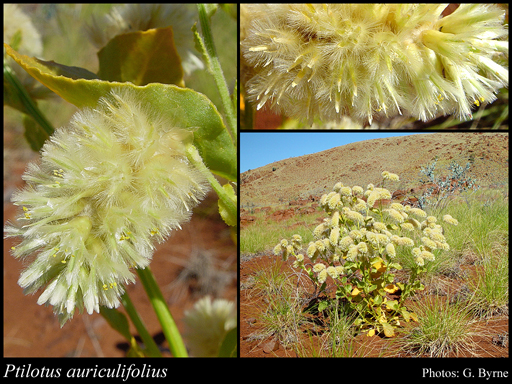- Reference
- Syst.Census Austral.Pl. 28 (1882)
- Conservation Code
- Not threatened
- Naturalised Status
- Native to Western Australia
- Name Status
- Current
Erect annual, herb, 0.4-1.3 m high, leaves, fleshy, 10-130 mm long, 4-65 mm wide; spike, green ovoid, to cylindrical, 15-110 mm long, 25-35 mm wide, bract, glabrous 4-5 mm long, bracteole 9-10 mm long; tepals 10-14 mm long; 5 fertile stamens; ovary hairy; style straight, 5.5-6.5 mm long, centrally fixed to ovary. Fl. green-white-yellow, May to Oct. Red sandy soils. Rocky hills, stony undulating plains.

Scientific Description
Annuals, stems several, more or less erect, glabrescent, with nodose or verticillate hairs. Leaves present, 10-130 mm long, 4-65 mm wide, glabrescent or glabrous, with nodose or verticillate hairs; basal rosette present; cauline leaves alternate. Spikes green, ovoid or cylindrical, solitary or clustered, with densely arranged flowers. Bracts 4-5 mm long, colourless, glabrous or hairy, awned or mucronate or not awned or mucronate, with an obscure or a prominent midrib. Bracteoles 7-8.4 mm long, colourless, glabrous, awned or mucronate, with a prominent midrib. Outer tepals 12-13.5 mm long, not entire. Inner tepals 11.8-13 mm long, with a basal tuft of hairs on inner face. Style 5.5-6.5 mm long, straight, centrally fixed to ovary. Seeds 1.7-1.8 mm long, dull, black or brown. Distribution: Eremaean Botanical Region; IBRA regions: Gascoyne, Great Sandy Desert, Little Sandy Desert, Pilbara.
Distribution
- IBRA Regions
- Gascoyne, Great Sandy Desert, Little Sandy Desert, Pilbara.
- IBRA Subregions
- Augustus, Chichester, Fortescue, Hamersley, Mackay, Roebourne, Rudall.
- IMCRA Regions
- Pilbara (nearshore).
- Local Government Areas (LGAs)
- Ashburton, East Pilbara, Karratha, Meekatharra, Port Hedland, Upper Gascoyne.